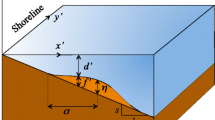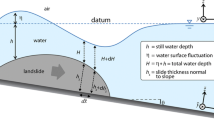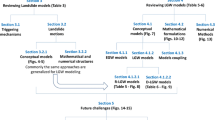Abstract
We present a short review of the state-of-the-art numerical tools that have been used for modeling landslide-generated waves. A comparative study is conducted on the physical properties of earthquake- and landslide-generated waves suggesting that both dispersion and nonlinearity effects may be neglected for the former waves whereas they may be considered for the latter ones. We introduce landslide tsunami models and group them into three classes: (1) models treating the moving mass as a fluid, (2) models estimating the initial water surface, and (3) models fed by the transient seafloor deformation. Selection of a particular model from the list of models introduced here depends on: (1) the dimensions of the source, (2) the available computing capacities, (3) availability of fine bathymetric grid, and (4) the purposes of the modeling.
Access this chapter
Tax calculation will be finalised at checkout
Purchases are for personal use only
Similar content being viewed by others
References
Assier-Rzadkieaicz S, Heinrich P, Sabatier PC, Savoye B, Bourillet JF (2000) Numerical modeling of a landslide-generated tsunami: the 1979 nice event. Pure Appl Geophys 157(10):1707–1727
Borrero JC, Legg MR, Synolakis CE (2004) Tsunami sources in the southern California bight. Geophys Res Lett 31(13):L13211
Brune S, Babeyko AY, Gaedicke C, Ladage S (2010) Hazard assessment of underwater landslide-generated tsunamis: a case study in the Padang region, Indonesia. Nat Hazards 53(2):205–218
Fine IV, Rabinovich AB, Bornhold BD, Thomson RE (2005) The Grand Banks landslide-generated tsunami of November 18, 1929: preliminary analysis and numerical modeling. Mar Geol 215:45–57
Fritz HM et al (2011) Field survey of the 27 February 2010 Chile tsunami. Pure Appl Geophys 168:1989–2010
Fujii Y, Satake K (2007) Tsunami source of the 2004 Sumatra–Andaman earthquake inferred from tide Gauge and satellite data. Bull Seismol Soc Am 97(1A):S192–S207
Fujii Y, Satake K, Sakai S, Shinohara M, Kanazawa T (2011) Tsunami source of the 2011 off the Pacific coast of Tohoku earthquake. Earth Planets Space 63:815–820
Geist EL, Lynett PJ, Chaytor JD (2009) Hydrodynamic modeling of tsunamis from the Currituck landslide. Mar Geol 264(1):41–52
Goto C, Ogawa Y, Shuto N, Imamura F (1997) Numerical method of tsunami simulation with the leap-frog scheme (IUGG/IOC time project), IOC Manual, UNESCO, No. 35
Gutenberg B (1939) Tsunamis and earthquakes. Bull Seismol Soc Am 29(4):517–526
Harbitz CB (1992) Model simulations of Tsunamis generated by the Storegge Slides. Mar Geol 105:1–21
Heidarzadeh M, Satake K (2013) Waveform and spectral analyses of the 2011 Japan Tsunami records on Tide Gauge and DART stations across the Pacific Ocean. Pure Appl Geophys 170(6–8):1275–1293. doi:10.1007/s00024-012-0558-5
Heinrich P (1992) Nonlinear water waves generated by submarine and aerial landslides. J Waterw Port, Coast, Ocean Eng ASCE 118(3):249–266
Heinrich P, Guibourg S, Mangeney A, Roche R (1999) Numerical modeling of a landslide-generated tsunami following a potential explosion of the Montserrat volcano. Phys Chem Earth A 24(2):163–168
Iglesias O, Lastras G, Canals M, Olabarrieta M, González M, Aniel-Quiroga Í, Otero L, Duran R, Amblas D, Casamor JL, Tahchi E, Tinti S, De Mol B (2012) The BIG’95 submarine landslide–generated tsunami: a numerical simulation. J Geol 120(1):31–48
Imamura F, Imteaz MA (1995) Long waves in two layer, governing equations and numerical model. Sci Tsunami Hazards 13:3–24
Insel I (2010) Landslide characteristics and tsunami generation, MSc thesis in METU Department of Civil Engineering, Coastal and Ocean Engineering Division
Jiang L, LeBlond PH (1992) The coupling of a submarine slide and the surface waves which it generates. J Geophys Res 97(C8):12731–12744
Kawamata K, Takaoka K, Ban K, Imamura F, Yamaki S, Kobayashi E (2005) Model of tsunami generation by collapse of volcanic eruption: The 1741 Oshima-Oshima tsunami. In: Satake K (ed) Tsunamis. Springer, Dordrecht, pp 79–96
Liu PL-F, Woo S-B, Cho Y-S (1998) Computer programs for tsunami propagation and inundation. Technical report, Cornell University
Liu PL-F, Wu T-R, Raichlen F, Synolakis C, Borrero JC (2005) Runup and rundown generated by three-dimensional sliding masses. J Fluid Mech 536:107–144
Lynett P, Liu PL-F (2002) A numerical study of submarine–landslide–generated waves and run–up. Proc R Soc Lond A 458:2885–2910
Lynett PJ, Borrero JC, Liu PL-F, Synolakis CE (2003) Field survey and numerical simulations: a review of the 1998 Papua New Guinea tsunami. Pure Appl Geophys 160:2119–2146
Myres EP, Baptsta AM (2001) Analysis of factors influencing simulations of the 1993 Hokkaido Nansei-Oki and 1964 Alaska tsunamis. Nat Hazards 23:1–28
Okal EA, Plafker G, Synolakis CE, Borrero JC (2003) Near-field survey of the 1946 Aleutian tsunami on Unimak and Sanak Islands. Bull Seismol Soc Am 93(3):1226–1234
Rabinovich AB, Thomson RE (2007) The 26 December 2004 Sumatra tsunami: analysis of Tide Gauge data from the World Ocean Part 1. Indian Ocean and South Africa. Pure Appl Geophys 164:261–308
Rabinovich AB, Thomson RE, Kulikov EA, Bornhold BD, Fine IV (1999) The landslide-generated tsunami of November 3, 1994 in Skagway Harbor, Alaska: a case study. Geophys Res Lett 26(19):3009–3012
Rabinovich AB, Thomson RE, Fine IV (2012) The 2010 Chilean tsunami off the west coast of Canada and the northwest coast of the United States. Pure Appl Geophys. doi:10.1007/s00024-012-0541-1
Satake K (2001) Tsunami modeling from submarine landslides. In: Proceedings of the international Tsunami symposium, Seattle, Washington (USA), 7–10 August 2001, vol 6, paper 6-4
Satake K (2012) Tsunamis generated by submarine landslides. Submarine mass movements and their consequences, Springer, pp 475–484
Satake K, Tanioka Y (1995) Tsunami generation of the 1993 Hokkaido Nansei-Oki earthquake. Pure Appl Geophys 144(3/4):803–821
Synolakis CE (2003) Tsunami and seiche. In: Chen WF, Scawthorn C (eds) Earthquake engineering handbook. CRC Press, Boca Raton, pp 1–90, Chapter 9
Synolakis CE, Bardet J-P, Borrero JC, Davies HL, Okal EA, Silver EA, Sweet S, Tappin DR (2002) The slump origin of the 1998 Papua New Guinea tsunami. Proc R Soc Lond A 458:763–789
Synolakis C, Bernard E, Titov V, Kanoglu U, Gonzalez F (2008) Validation and verification of tsunami numerical models. Pure Appl Geophys 165(11–12):2197–2228
Thomson RE, Rabinovich AB, Kulikov EA, Fine IV, Bornhold BB (2001) On numerical simulation of the landslide-generated tsunami of November 3, 1994 in Skagway Harbor, Alaska. In: Hebenstrait GT (ed) Tsunami research at the end of a critical decade, vol 18, Advances in natural and technological hazards research. Kluwer Academic Publishers, Dordrecht, pp 243–282, 304 p
Tinti S, Bertolucci E, Romagnoli R (1999) Modeling a possible Holocenic landslide-induced tsunami at Stromboli volcano. Phys Chem Earth 24(5):423–429
Tinti S, Maramai A, Armigliato A, Graziani L, Manucci A, Pagnoni G, Zaniboni F (2006) Observations of physical effects from tsunamis of December 30, 2002 at Stromboli volcano, southern Italy. Bull Volcano 68(5):450–461
Titov VV, Synolakis CE (1998) Numerical modeling of tidal wave runup. J Waterw Port Coast Ocean Eng 124(4):157–171
Wang X (2009) User manual for COMCOT version 1.7 (first draft), Cornel University, pp 65
Watts P (1998) Wavemaker curves for tsunamis generated by underwater landslides. J Waterw Port Coast Ocean Eng 124(3):127–137
Watts P, Grilli ST, Kirby JT, Fryer GJ, Tappin DR (2003) Landslide tsunami case studies using a Boussinesq model and a fully nonlinear tsunami generation model. Nat Hazards Earth Syst Sci 3(5):391–402
Watts P, Grilli ST, Tappin D, Fryer GJ (2005) Tsunami generation by submarine mass failure. II: predictive equations and case studies. J Waterw Port Coast Ocean Eng 131(6):298–310
Weiss R, Wunnemann K, Bahlburg H (2006) Numerical modelling of generation, propagation and run-up of tsunamis caused by oceanic impacts: model strategy and technical solutions. Geophys J Int 167:77–88
Weiss R, Krastel S, Anasetti A, Wuennemann K (2013) Constraining the characteristics of tsunami waves from deformable submarine landslides. Geophys J Int. doi:10.1093/gji/ggt094. http://gji.oxfordjournals.org/content/early/2013/04/05/gji.ggt094
Yalçıner AC, Alpar B, Altınok Y, Özbay İ, Imamura F (2002) Tsunamis in the Sea of Marmara: historical documents for the past, models for the future. Mar Geol 190(1):445–463
Acknowledgments
This study was funded by the Alexander von Humboldt Foundation in Germany. The first author is grateful to Prof. Kenji Satake (University of Tokyo, Japan) for his supports and fruitful discussions. This manuscript benefited from detailed and constructive reviews by Dr. Carl B. Harbitz (Norwegian Geotechnical Institute, Norway), Prof. Costas E. Synolakis (University of Southern California, USA) and Dr. Anawat Suppasri (Tohoku University, Japan) for which we are sincerely grateful.
Author information
Authors and Affiliations
Corresponding author
Editor information
Editors and Affiliations
Rights and permissions
Copyright information
© 2014 Springer International Publishing Switzerland
About this chapter
Cite this chapter
Heidarzadeh, M., Krastel, S., Yalciner, A.C. (2014). The State-of-the-Art Numerical Tools for Modeling Landslide Tsunamis: A Short Review. In: Krastel, S., et al. Submarine Mass Movements and Their Consequences. Advances in Natural and Technological Hazards Research, vol 37. Springer, Cham. https://doi.org/10.1007/978-3-319-00972-8_43
Download citation
DOI: https://doi.org/10.1007/978-3-319-00972-8_43
Published:
Publisher Name: Springer, Cham
Print ISBN: 978-3-319-00971-1
Online ISBN: 978-3-319-00972-8
eBook Packages: Earth and Environmental ScienceEarth and Environmental Science (R0)




